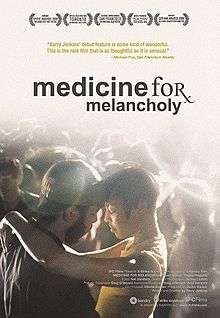Medicine for Melancholy
| Medicine for Melancholy | |
|---|---|
 Film poster | |
| Directed by | Barry Jenkins |
| Produced by |
|
| Written by | Barry Jenkins |
| Starring |
|
| Cinematography | James Laxton |
| Edited by | Nat Sanders |
Production company |
|
| Distributed by | IFC Films |
Release dates |
|
Running time | 88 minutes |
| Country | United States |
| Language | English |
| Budget | $15,000[1] |
| Box office | $111,551[2] |
Medicine for Melancholy is a 2008 independent romantic drama film written and directed by Barry Jenkins. The film stars Wyatt Cenac, Tracey Heggins, and Elizabeth Acker. The film appeared at several film festivals in 2008, including South by Southwest, Maryland Film Festival, and The Toronto International Film Festival. The film was produced on a budget of $15,000, lent from a friend of Jenkins.[1]
Plot
Medicine for Melancholy chronicles the one-day romance of Micah (Wyatt Cenac) and Jo' (Tracey Heggins), two black twenty-somethings, who have a one night stand and end up spending a full day and night together, despite Jo’s long-distance relationship with a wealthy, white gallery owner. The characters wake up in someone else's bed after a party, and head their separate ways. Jo' leaves her wallet in their shared taxi, and they reconnect when he returns it to her at her apartment. Throughout the day, Micah and Jo visit the Museum of the African Diaspora, stumble upon an affordable housing coalition meeting, and attend a concert. Venturing around San Francisco, the characters discuss race and gentrification with regard to the low percentage of African Americans living in San Francisco.[3] Micah is openly critical of Jo's interracial relationship, as he struggles to reconcile his African American identity with the predominately white world of the hipster scene in San Francisco.
Themes
Medicine for Melancholy mainly confronts themes of African American assimilation into "hipster" or "indie" culture. The city of San Francisco also emphasizes African-Americans as the minority, since the race makes up 7% of the total population.[4][5]
Racial identity
Writer and director Barry Jenkins has described the film's two main characters as "playing out a debate back and forth about identity politics". Each of the two main characters embodies an ideology. Jenkins saw the character of Micah as a man who was always building barriers, whereas Jo thinks that race is a limiter.[6] Accusing Jo of assimilation, Micah strives to reclaim his essential "blackness" as Jo' contrastingly claims Micah has a "hang up" about his race and strives to overcome her own.
Production
Jenkins wrote the film two years before its release.[5]
Visual effects
The film includes desaturation of images.[5] Filmmakers went through the film shot by shot and pulled out the majority of color. In an interview, director Barry Jenkins stated that certain scenes in the film have more color to reflect when the characters aren't thinking about race or housing issues.[7]
Critical reception
Roger Ebert of the Chicago Sun Times gave the film 3.5 out of 4 stars, calling the actors "effortlessly engaging" and the direction "assured"; he also noted the film was "beautifully photographed".[8] It was a New York Times Critics' Pick [9] and nominated for three 2008 Independent Spirit Awards.[10] On Rotten Tomatoes, it has an 83% fresh rating.[11]
Accolades
| Award | Category | Recipient(s) and nominee(s) | Result | Ref(s) |
|---|---|---|---|---|
| Independent Spirit Awards | Best First Feature | Medicine for Melancholy | Nominated | [12] [13] |
| Best Cinematography | James Laxton | Nominated | ||
| Someone to Watch Award | Barry Jenkins | Nominated | ||
| San Francisco Film Critics Circle | Marlon Riggs Award | Barry Jenkins | Won | [14] |
References
- 1 2 Stephenson, Will. "Barry Jenkins Slow-Cooks His Masterpiece". The Fader. Retrieved 2016-10-22.
- ↑ "Medicine for Melancholy (2009)". Box Office Mojo. Retrieved 22 October 2016.
- ↑ U.S. Census Bureau. "San Francisco County Quickfacts". Retrieved 5 March 2012.
- ↑ U.S. Census Bureau. "San Francisco County Quickfacts". Retrieved 5 March 2012.
- 1 2 3 Lim, Dennis (21 January 2009). "With 'Medicine for Melancholy,' Barry Jenkins Examines Race and a Future Beyond It". The New York Times. Retrieved 22 October 2016.
- ↑ https://tribecafilm.com/stories/512c0d351c7d76d9a900058e-a-cure-for-the-blues-medi
- ↑ https://tribecafilm.com/stories/512c0d351c7d76d9a900058e-a-cure-for-the-blues-medi
- ↑ {http://www.rogerebert.com/reviews/medicine-for-melancholy-2009}
- ↑ http://www.nytimes.com/movies/movie/451314/Medicine-for-Melancholy/awards
- ↑ Olsen, Mark. "Watch: Barry Jenkins' anticipated indie drama 'Moonlight' starring Mahershala Ali and Janelle Monáe". Los Angeles Times. Retrieved 29 October 2016.
- ↑ http://www.rottentomatoes.com/m/medicine_for_melancholy/?search=medicine%20for%20melancholy
- ↑ Morris, Wesley. "The 24th Spirit Awards". Boston.com. Retrieved 29 October 2016.
- ↑ "Film Independent Spirit Awards: 31 Years of Nominees and Winners" (PDF). Retrieved 29 October 2016.
- ↑ "Bay Area film critics love 'Hurt Locker'". The San Francisco Examiner. Retrieved 29 October 2016.